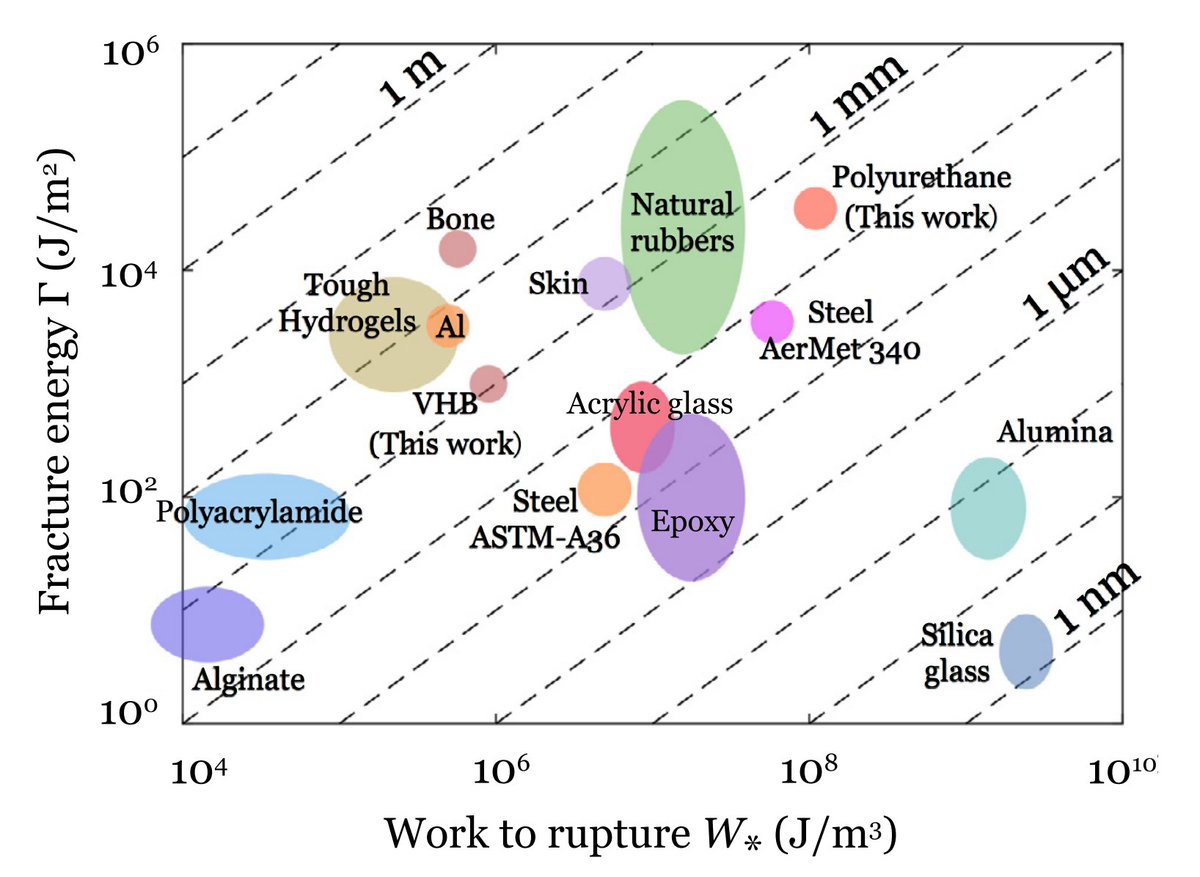People do not consistently name these two quantities:
A. Toughness (J/m2), Gc, measured using a sample with a precut crack.
B. Work of fracture (J/m3), Wc, measured using a sample with no precut crack.
They have different units. Be careful how each paper names them.
A. Toughness (J/m2), Gc, measured using a sample with a precut crack.
B. Work of fracture (J/m3), Wc, measured using a sample with no precut crack.
They have different units. Be careful how each paper names them.
Note three lengths:
f = length of the largest crack-like flaw
c = length of a precut crack
R = fractocohesive length.
Let us agree that f << c.
@jasongsteck @Junsoo_twit @ToLiTeng @ykutsovsky
f = length of the largest crack-like flaw
c = length of a precut crack
R = fractocohesive length.
Let us agree that f << c.
@jasongsteck @Junsoo_twit @ToLiTeng @ykutsovsky
1. If f < R, Wc is independent of flaw length, and is a material constant.
2. If R < c, Gc is independent of crack length, and is a material constant.
Define R = Gc/Wc.
Defined this way, Gc, Wc and R are three material constants.
@CretonCost @Tengh_Yin @srledm87 @yecheng_w
2. If R < c, Gc is independent of crack length, and is a material constant.
Define R = Gc/Wc.
Defined this way, Gc, Wc and R are three material constants.
@CretonCost @Tengh_Yin @srledm87 @yecheng_w
This paper discusses these ideas.
https://doi.org/10.1016/j.eml.2016.10.002
In">https://doi.org/10.1016/j... the figure, Gc, Wc, and R are three material constants.
A remarkable fact: of all materials plotted, silica has the smallest Gc, but the largest Wc.
@ProfZhaoMIT @ProfBuehlerMIT @ProfGraceGu @michelleoyen
https://doi.org/10.1016/j.eml.2016.10.002
In">https://doi.org/10.1016/j... the figure, Gc, Wc, and R are three material constants.
A remarkable fact: of all materials plotted, silica has the smallest Gc, but the largest Wc.
@ProfZhaoMIT @ProfBuehlerMIT @ProfGraceGu @michelleoyen
3. If R < f, Wc is flaw-sensitive and is not a material constant. But Gc is a material constant.
4. If c < R, Gc is not a material constant, but Wc is.
5. If f < R < c, both Wc and Gc are material constants.
@RuobingB @DrJiaweiYang @Ljycanon @ZhengJia_ZJU
4. If c < R, Gc is not a material constant, but Wc is.
5. If f < R < c, both Wc and Gc are material constants.
@RuobingB @DrJiaweiYang @Ljycanon @ZhengJia_ZJU
For a polyacrylamide, R = 1 mm. The condition f < R < c is readily satisfied in experiments. Thus, both Gc and Wc are material constants.
https://doi.org/10.1016/j.jmps.2019.06.018">https://doi.org/10.1016/j...
https://doi.org/10.1016/j.jmps.2019.06.018">https://doi.org/10.1016/j...

 Read on Twitter
Read on Twitter


